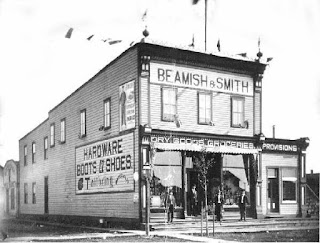By Ian Macdonald
Commercial retail activity is a significant part of the cultural heritage of a community through speaking to the way people bought and sold goods and services. Communities along the height of land, compared to other Northern Ontario communities, remained comparatively remote except for the railroad until the 1960’s.
Image: McNamara shop interior
General store buildings in those early days were simple and straightforward with gable or shed roofs. They were generally one and a half or two storey structures with the sales floor on the main floor. Granite bedrock in most locations lurked only a few feet below ground level forcing the main floor to be two to five feet above grade if basement space was required. Second floors were typically residential and occasionally commercial office space depending on the building location. Internal organization of the stores were mostly symmetrical with a clearly defined main entrance located on the main axis and recessed to form an entry alcove. This allowed for increased window area and larger displays.
Shop areas had high ceilings and the front façade included large plate glass display windows. Long counters were located on one or both sides of the main customer circulation area and business was mostly conducted over the counter. Timber construction was predominant for both structural and decorative purposes with little option but to use local labour skills and resourceful use of materials. The store front, however, was different and was seen to be one of the main factors in establishing a competitive edge in a highly competitive market.
Image: Beamish and Smith store
The importance of the store front in commercial retailing is best illustrated in one of the first stores built in Chapleau by James McNiece Austin in Chapleau in the 1890’s on the north east corner of Birch and Young Street. The original business had been established on a site 100 feet to the east by T.A.Austin in 1885 and sold to his brother, James McNiece Austin in 1888 who operated the business for five years before selling out in 1903 to R.A. Beamish and Stuart Smith. This new enterprise became known as Beamish and Smith and lasted four years before it was acquired in 1907 by the partnership of Stuart Smith and V.T.Chapple and became Smith and Chapple.
The original store building facing Birch Street was approximately thirty feet wide, a hundred feet deep and typical of most general stores of that era. The structure was of rudimentary wood frame construction with a flat roof slightly sloping south to north. The plan organization of the building was symmetrical around a glazed double door main entrance. It was similar to most other commercial buildings in the newcommunity with the exception of the Birch Street store front that incorporated enough architectural features to fill a history text book.
Image: architectural drawing of Smith and Chapple
The Birch Street store front was consistent with established principles associated with highly urban areas like London, England where the shop is usually part of an established urban streetscape rather than a single free standing corner building on the Canadian frontier. These architectural features included overly large wood panelled corner pilasters to establish physical separation from neighbouring buildings and supported a bold and complex cornice at roof level. Bold cornice detailing was also an established way of providing clear definition between the shop front and the upper floor. The store also had the advantage of a large blank wall surface facing Young Street that allowed for additional signage. Entrance to the store was a recessed glazed double door that provided a strongly defined entrance alcove and additional plate glass display area.
Image: Smith and Chapple original storefront
The store had changed owners three times before it became Smith and Chapple in 1907. There were no changes to the architectural features of the original store front during these changes in proprietorship. The name of the respective owners was simply repainted on the second-floor wall facing Birch Street and minor changes were made in the signage over the plate glass display windows.
Image: Smith and Chapple 1915 Expansion
V.T. Chapple who is recorded as being the most energetic and ambitious of the Smith and Chapple partners, tripled the size of the original store with a building expansion in 1915. The expansion was effectively the double replication of the original building which faithfully maintained and repeated the same distinctive features of the original.
Image: Smith and Chapple final Expansion
The store would be further expanded one more time during the depression years with the addition of a butcher shop, groceteria and basement level snack bar and shop. This renovation included removal of most of the distinctive architectural features of the original building. Decorative ornament was eliminated and the building surfaces were smoothed out to give a more “modern” appearance and a large Smith and Chapple sign would stretch over the entire length of the building facing Birch Street.
Image: Village Shops exterior image
The store remained this way until 1987 when it was acquired by the Bignucolo family who renovated the building and rebranded the business as “The Village Shops” . This renovation, responding to more open and contemporary retailing principles, Included removal of Interior walls and partitions and conversion of second floor commercial retail space to eight apartment units.
Image 8 Village Shops interior image
This venerable old building is one of the few early commercial retail buildings that has endured the ravages of time and successfully adapted to the many different eras of retailing concepts in the region.
Ian advised that Images in this article are from the Vincent Crichton Sr. Chapleau Historical Photo Collection are published with the kind permission of Dr. Vince Crichton Jr.
Photos 7 and 8 of the Village Shops are provided by Lucy Bignucolo











No comments:
Post a Comment